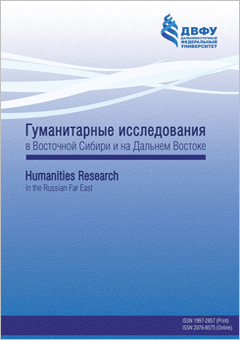Decoration traditions in the ancient cultures of the Pacific: Lapita pottery ornamentation and Polynesian tattoo
DOI:
https://doi.org/10.24866/1997-2857/2021-1/5-14Keywords:
tattoo, Polynesia, Lapita, pottery, ornamentationAbstract
The practice of tattooing, as one of the most technically complex types of ritual attributes, is well-known thanks to abundant archeological and ethnographical data that come from a wide variety of cultures – both in terms of chronology and geography. The article focuses on such data from Polynesia that allows us not only to trace exceptionally spectacular local tattoo styles and tool kits for tattooing but also to link decorative compositions of the tattoo with the ornamentation of Lapita pottery.
Downloads
References
Ратманов М.И. «Чтобы лучше цену дать своему Отечеству...»: первая русская кругосветная экспедиция (1803–1806) в дневниках Макара Ратманова. СПб.: Крига, 2014.
Табарев А.В., Патрушева А.Е. Неолит островной части Юго-Восточной Азии: особенности, гипотезы, дискуссии // Теория и практика археологических исследований. 2018. № 1. С. 165–179.
Табарев А.В., Патрушева А.Е., Куэвас Н. Погребения в антропоморфных сосудах на территории Филиппин // Археология, этнография и антропология Евразии. 2019. Т. 47. № 2. С. 40–47.
Ancient ink: the archaeology of tattooing. Seattle: University of Washington Press, 2017.
Barnes, G., 2006. Curiosity, wonder, and William Dampier’s painted prince. Journal for Early Modern Cultural Studies, Vol. 6, no. 1, pp. 31–50.
Burley, D.V., 1998. Archaeology and the Tonga past, 2850–150 BP. Journal of World Prehistory, Vol. 12, pp. 337–392.
Chiu, S., 2007. Detailed analysis of Lapita face motifs: case studies from Reef/Santa Cruz Lapita sites and New Caledonia Lapita site 13A. Terra Australis, Vol. 26, pp. 241–264.
Clark, G. and Langley, M.C., 2020. Ancient tattooing in Polynesia. The Journal of Island and Coastal Archaeology, Vol. 15, no. 3, pp. 407–420.
Kirch, P.V., 1997. The Lapita peoples: ancestors of the Oceanic World. Oxford: Blackwell Publishers.
Krutak, L., 2013. Embodied symbols of the South Seas: tattoo in Polynesia. URL: https://www.larskrutak.com/embodied-symbols-of-the-south-seas-tattoo-in-polynesia/
Robitaille, B., 2007. A preliminary typology of perpendicularly hafted bone tipped tattooing instruments: toward a technological history of Oceanic tattooing. In: Gates St.-Pierre, Ch. and Walker, R. eds., 2007. Bones as tools: current methods and interpretations in worked bone studies. Oxford: Archaeopress, pp. 159–174.
Sand, C., 2007. Looking at the big motifs: а typology of the central band decorations of the Lapita ceramic tradition of New Caledonia (Southern Melanesia) and preliminary regional comparisons. Terra Australis, Vol. 26, pp. 256–287.
Spriggs, M., 1990. The changing face of Lapita: transformation of a design. In: Spriggs, M. ed., 1990. The Lapita design, form and composition: proceedings of the Lapita design workshop. Canberra: Australian National University Press, pp. 83–122.
Spriggs, M., 2019. The hat makes the man: masks, headdresses and skullcaps in Lapita iconography. Terra Australis, Vol. 52, pp. 257–273.
Terrell, J.E. and Schechter, E., 2009. The meaning and importance of the Lapita face motif. Archaeology of Oceania, Vol. 44, no. 2, pp. 44–55.
Torrence, R. and White, J.P., 2001. Tattooed faces from Boduna Island, Papua New Guinea. Terra Australis, Vol. 17, pp. 135–140.
Torrence, R. et al., 2018. Tattooing tools and the Lapita cultural complex // Archaeology in Oceania, Vol. 53, pp. 58–73.
Downloads
Published
Issue
Section
License
Copyright (c) 2021 Алина Романовна Агапова, Ника Николаевна Ковалева, Андрей Владимирович Табарев

This work is licensed under a Creative Commons Attribution-NonCommercial-NoDerivatives 4.0 International License.















